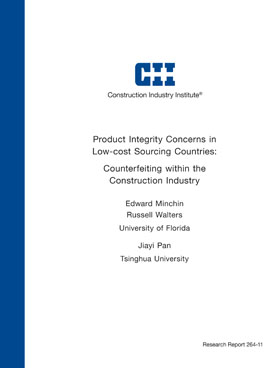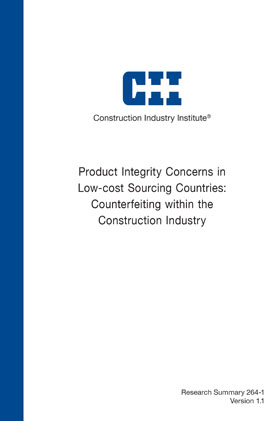
Product Integrity Concerns in Low-cost Sourcing Countries: Counterfeiting within the Construction In
Counterfeiting has been around since ancient times. The act of copying and printing fake currency was once widespread, and was considered a threat to a nation’s economy and general stability. With globalization efforts that followed World War II, the problem of counterfeiting became an international problem, with the problem centered around Japan’s developing manufacturing-based economy. As Japan’s economy started maturing in the late 1960’s, the center of the counterfeiting industry moved to Korea. As their economy improved, the center of the problem moved to mainland China, where it resides today.
In the mid-1980s, it was estimated that counterfeit products composed nine percent of total world trade in manufactured goods. Even though many countries have signed agreements to protect intellectual property rights, counterfeit products are more available than ever in both world and national markets. According to the World Trade Organization, world trade increased by 47% from 1990 to 1995, but during this same period the trade of counterfeit products increased by 150%. Since 1995, the problem has continued to grow. As of 2003, including counterfeit products that are produced and marketed domestically within a country, the total value of counterfeit products marketed in the world was estimated to be more than $1 trillion annually.
In recent years, as stories of counterfeit retail products such as baby food, dog food, jeans, handbags, DVDs, etc. made the news, questions emerged as to whether counterfeiting was a problem in the construction industry. A single incident in 2006 involving construction of a U.S. government installation in Europe by a prominent CII-member U.S. contractor provided the impetus for this research project.
The facility design included 48 name-brand telecommunication routers which the contractor purchased from a US Fortune 500 authorized distributor of such products. Within the first few months of service, 12 of the devices progressively failed. Upon investigation of what was clearly an epidemic failure rate, it turned out that all 48 devices were China-origin counterfeits. Not only were they counterfeit, but when the serial numbers were examined, they were all valid. The counterfeiters were so sophisticated that they had applied serial numbers of genuine identical devices for which the original purchaser(s) had not bothered to register with the manufacturer.
This incident, and the resulting investigations, led this CII contractor into the little-explored world of sophisticated counterfeiting of non-retail products. As a result, the company encouraged CII to pursue this research topic—focusing on the most threatening tactics of counterfeiting for our industry: producing knockoff branded industrial products that appear genuine in every way, but that are made without regard for performance integrity; or producing non-branded raw materials or commodity items which have been deliberately (and often toxically) tainted to produce deceptively-favorable test results, and/or accompanied by apparently certified documentation attesting to compliance with specified content or quality. The common element in these tactics is intentional deceit; not simply shoddy workmanship or inadvertent flaws which our traditional QA/QC processes routinely detect.
CII Research Team (RT) 264 conducted over 200 face-to-face interviews with industry and governmental leaders in the People’s Republic of China, Taiwan, Hong Kong, the United Kingdom, Pakistan, Canada, and the United States. The team also conducted approximately 50 telephone interviews. A massive amount of data was gathered, amounting to over 7,000 data points.
Some findings and documented examples of counterfeiting identified during this study:
- A counterfeit crane had its boom collapse killing a construction worker.
- A counterfeit steel valve failed under steam pressure with steam temperature at 1006 degrees, scalding several workers to death.
- A counterfeit pressure vessel ruptured while in operation, killing two employees.
- 1,000,000 counterfeit Square D circuit breakers entered the United States in one shipment from China. Over 750,000 of these are still unaccounted for in the supply chain.
- Counterfeit five-inch (5") stop check valves were installed at a Southeastern U.S. nuclear power plant.
- The U.S. Navy has video of Chinese workers with sledge hammers breaking open old computers, video games, children’s toys, etc., removing the microchips, and then re-marking and selling them to the U.S. Navy as new and genuine products for use in critical weapons systems and other operational applications in submarines and warships.
Ways for the industry and the individual contractor or owner to fight and mitigate the problem include:
- Supply chain integrity. Confirm and verify that every link in the supply chain is secure and observed. Responsible manufacturers have designed and implemented highly-reliable and secure distribution networks that ensure product integrity. The use of brokers, re-sellers, and unauthorized distributors (at any level in the supply chain) are common entry-points for counterfeit products. Your immediate supplier could be trustworthy, but could also be a victim of counterfeit entry points up stream.
- Other supply chain management activities such as enhanced supplier pre-qualification, more diligent sourcing practices, manufacturing surveillance, resident inspection, third party verification, unscheduled in-process inspections, and any other exercise that will also give the owner/contractor more confidence in the integrity of the products they’re paying for.
- Positive Materials Identification (PMI) or other methods of validation
- Put more emphasis on documenting the quality and integrity of the sourcing of raw materials and commodity items.
- Increased need for education of Customs officials and other law enforcement agencies regarding construction goods and materials – not just the higher-profile retail products.
- Adopt a “zero tolerance” policy regarding counterfeiting. Report all incidences of counterfeiting and never fail to support any law enforcement agency’s effort to prosecute.
RT 264 has developed an exhaustive list of actions and initiatives the industry and individual contractors and owners can take to avoid, reduce, or mitigate the problem. The team also developed a list of tip-offs or warning signs that will help procurement, quality, and field personnel know that an item under consideration for purchase or use has a higher than usual probability of being counterfeit.
It is not uncommon at all to receive high quality goods from places like China, India, Russia, and Brazil, and today’s economy requires that companies purchase or manufacture goods from or in these places in order to be competitive. But having a supply chain deliver quality most of the time is not good enough, especially with what this research has discovered. Assuring one’s self of receiving product quality, and just as important product integrity, 100% of the time requires consistent and unwavering diligence on the part of the purchaser (owner/contractor). Greater help from governments all over the world would also help immensely.


